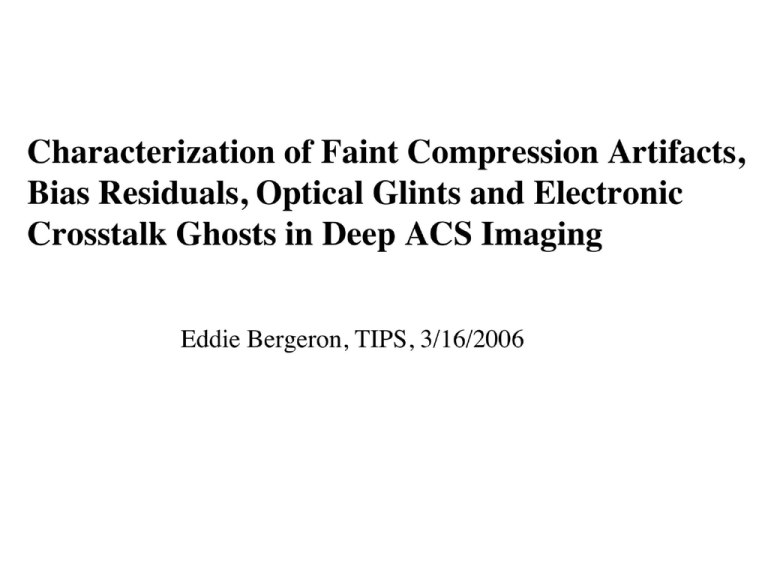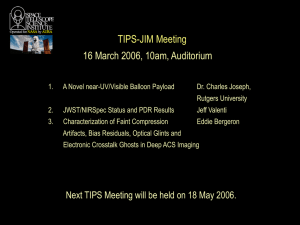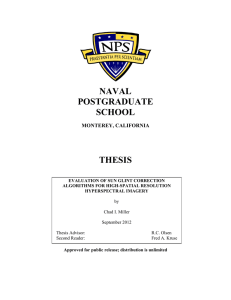Document 10533638
advertisement

Horizontal Striping Vertical Striping Superdark has bias “hot column” residuals in it. These don’t scale linearly with exposure time and print onto science data. Superbias images below with hot pixels removed, then smoothed to show structure bias stripes removed with bias stripes Pipeline bi-weekly superdarks show similar bias striping Other macro-scale structures in the dark are likely amplifier bias shape differences between the 1000s dark exposure and the 0s bias subtracted from it. The 1200s science exposures will have similar (but not exactly the same) residuals. Low/hi corners and vertical/horizontal gradients across the quads are most likely bias, not dark current Glint (internal optical reflection) Optical glint, possibly from an off-chip source crosses the field diagonally. Would like to characterize its behaviour (motion and intensity) so it can be subtracted from the data before drizzling. The glint in each chip was measured at 3 points along its length to get its slope and amplitude Fitting lines to the glint across both chips revealed that its is pivoting about a point near the upper left edge of chip2. A model glint image was build by shifting and rotating all the images to the same glint orientation and filtering sources. This model, masked to minimum extent then rotated, shifted and scaled, was then subtracted from each input image before drizzling. Chip 2 Chip 1 Close-up of Chip 1 Glint Residual “sky” Subtraction Since many of the residual bias/dark structures discussed previously have not been corrected by the reference files, a catch-all sigma-clipped average, source-masked sky made from all of the input images is subtracted from each image before drizzling. Some glint residual is visible here and that will oversubtract from the data, leaving a faint dark residual in the final image. This is an image of all the systematic noise remaining after the pipeline calibration Amplifier Ringing? Moderately bright star (but unsaturated in 1200s) leaves a long decaying, very faint trail in the serial read direction. The decay is slow enough to wrap around to the next row. This is similar to behaviours seen in WFPC2 and NICMOS, but much, much fainter. Its likely this is present for all bright, sharp sources, but only visible above the noise with deep imaging like UDF Correctable with a sum of exponentials in the serial read direction Electronic Crosstalk Ghosts Sources produce dark ghosts of themselves in the opposite quadrant and even in the quads of the other WFC CCDs. This is some form of electronic crosstalk (see ACS ISR 4-12, 4-13, Giavalisco 2004 for details). Even in this GAIN=2 data, the ghosts are quite prominent. In the drizzled z-band image, the ghosts are smeared by the dithering. Due to the orientations of the readout directions of the 4 WFC quadrants, the ghosts move in the opposite direction of the sources in the serial readout direction (X), but they move together in the parallel readout direction (Y). Ghosts and their sources Serial Parallel C Serial Parallel A Serial The same logic applies to all 4 quads. D Y Parallel If a source in quad D moves in +X,+Y, its ghost in quad C moves in -X,+Y. Chip2 Parallel ACS WFC readout orientations. Sources and ghosts follow the arrows. B Serial Chip1 X Flip -X,Y then copy Serial Parallel C D Y A Serial Parallel Parallel Three permutations -3 drizzles - gives you all 12 ghost quads. (3 ghosts per 4 source quads) Serial Parallel Use a trick to make drizzled images of the ghosts: Flip the quads in appropriate directions, then drizzle! Example for l-r interchip permutation B Serial Flip -X,Y then copy X Once you have high S/N images of ghosts you can either subtract the image directly, or try to build a model of the ghost behavior as a function of source - that’s the next step… Side-by-Side Comparison Original (same stretch) Cleaned Still to do: E-ghosts, better glint subtraction, amp ringing correction end transmission





